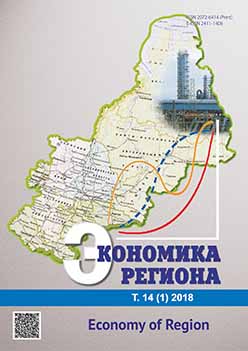Оценка конкурентной среды на региональных рынках
Assessment of the Competitive Environment in the Regional Markets
Author(s): Alexandr Yuryevich Kokovikhin, Ekaterina Sergeevna Ogorodnikova, Dina Williams, Andrey Yevgenyevich PlakhinSubject(s): Economy, Geography, Regional studies
Published by: Институт экономики Уральского отделения Российской академии наук
Keywords: competitive environment; entrepreneurship; estimation of competitiveness maturity; standard of competitiveness development; socially significant markets; priority markets; consequences of institutiona
Summary/Abstract: The maturity of competitiveness and its dynamics is a focus of assessing state decisions aimed for economic growth. To estimate the maturity of the competitive environment, researchers apply different methods. However, synthesis of the existing approaches has revealed the comparability of various approaches to the assessment of the maturity of the competitive environment. The authors have proposed a methodology of comprehensive assessment, which includes the estimation of market concentration, diverging trends of revenue and costs, survey of entrepreneurs. The comparison of the estimations employs a three-stage model of data processing. This model consequently compares the characteristics of markets maturity obtained while implementing the above-mentioned approaches. We have tested the methodology using the materials of the research performed in 2015–2017 on the territory of Sverdlovsk Region. Our study has shown the following essential results. Firstly, we have classified socially important and priority markets of Sverdlovsk Region by the level of competitiveness development. Most of the markets are estimated as the markets with missing and low competition. The majority of them represent the segments of the education market. The authors also grouped highly competitive markets, which include the retail market, the market of overland carriage of passengers, the market of communication services and the market of cultural services. Moreover, we specified the group of markets with a moderate competition. This group consists of the market of housing and communal services, social services market, and the market of medical products. Secondly, we confirmed that the assessment of a competitive situation using one of the approaches is imprecise. Both in 2015 and in 2016, there is no convergence in estimates received by statistical and survey methods for the market of social services and certain segments of the education market. The authors explain it by a considerable share of the “grey” sector in these markets, which cannot be fully analyzed. Hence, we recommend to use survey methods to analyze competition in the markets of education and social services as these methods allow considering insider information and the illegal tendencies of their development. The results of the research may contribute the analysis of competition as well as the development of antimonopoly policy at the federal and regional levels.
Journal: Экономика региона
- Issue Year: 14/2018
- Issue No: 1
- Page Range: 79-94
- Page Count: 15
- Language: Russian

